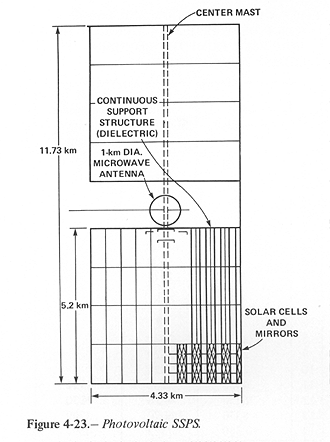
SATELLITE SOLAR POWER STATIONS (SSPS)
A geosynchronous orbit is on the Earth's equatorial plane with a radius at which a satellite matches the Earth's angular velocity, and is stationary with respect to an observer on the Earth's surface. This orbit lends itself to communications, monitoring of the Earth's surface, and power transmission to the Earth's surface, all of which need to be done more or less continuously without interruption of service.
The power transmission concepts call for the collection of solar power by huge satellites, conversion to electrical power by either photovoltaic (ref. 34) or thermal methods (ref. 35) and transmission to the Earth by 10 cm microwave power beams (ref. 36). On the Earth's surface the power is to be received, rectified and then fed into the power grid.
The photovoltaic conversion satellite concept (see fig. 4-23)

In the thermal conversion concept (under study by Boeing) 10,000 individually-steered facets concentrate the sunlight by a factor of 2000 into a cavity (personal communication with Gordon Woodcock, Boeing). In the cavity the sunlight heats helium which, in turn, drives Brayton cycle turbogenerators. The low end of the cycle is a large radiator operating at 550 K. (The model for the cycle and turbogenerators is a 50MW plant in Oberhausen, Germany which uses a closed cycle with helium as a working fluid.) Four independent sections, each with 1 cavity, make up this SSPS. The power transmission is the same as for the photovoltaic SSPS. Studies indicate a specific mass of 6.5 kg/kW for 10 GW output received on Earth (ref. 35).
A solar power satellite built at the colony is transferred to geosynchronous orbit, requiring several months to complete the journey. Once in place the 5-20 GW system's output is tied into the terrestrial surface power grid to provide relatively cheap electricity to Earth.
A photovoltaic SSPS is expected to require little maintenance. Periodically, to overcome radiation damage, the solar cell arrays have to be annealed by heating them perhaps 50 degrees C above ambient operating temperature; this is done automatically by the satellite. Failure of such parts as amplitron tubes and solar blankets, and the inevitable but infrequent hits by small meteoroids require repairs. A "smart" machine replaces parts on the transmitting antenna and the solar cell blankets, but repair of structural damage requires several people to help the "smart" machines.
It is desirable to do as little maintenance of solar power satellites as possible with people because the structure is not designed to provide life support for them. Also, the huge size of the satellite makes the amount of work one person can do negligible compared to a machine. For maintenance of a 5-20 GW photovoltaic power satellite a crew of less than 6 people is projected. For a thermal conversion power satellite more people are needed since there are more moving parts, but a crew of less than 50 is enough for a 10 GW satellite. The repair crew is housed in a small shack or "caboose" near the center of the satellite and rotated periodically to the habitat.
Because the satellite is a cheap stable orbital platform in sight of Earth all the time it also has on it packages of Earth-sensing instruments, direct broadcast TV stations, and communications links. Most of this equipment is located near the "caboose," so that the maintenance crew can take care of these units as well.
The major force on an SSPS is the gravity gradient torque. The amount of propellant required for station keeping depends upon the satellite's mass distribution and upon the station-keeping strategy adopted.